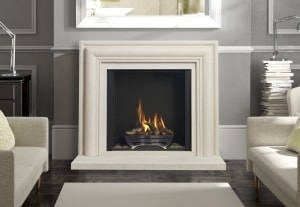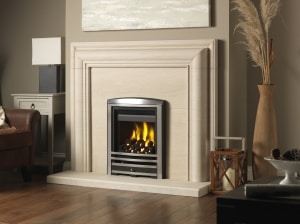You’ve settled the design of your new home, the interior fixtures, fittings and finishes but what about the heating appliance in your living room – do you opt for a gas fire? or maybe you’re tempted by an electric fire? This article will be able to help you make a decision that is right for you when your considering gas or electric fireplaces.
Gas and Electric Fires:
There are a myriad of choices when it comes to gas or electric fires for your home, and at times it can be quite confusing. Peter Mintoft, Technical Director of Charlton & Jenrick Ltd, manufacturer of Infinity, Paragon, Matchless Gas Fireplaces and Electric Fires and Fireline wood stoves, takes a look at what you need to consider when deciding on a fire or fireplace to create the right ambience in your newly finished home.

The highly efficient Infinity 880FL in the Regency style Rembrandt suite with black liners and fire basket.
The Focal Point:
The consideration of what type of secondary ‘focal point’ heating you choose often has more to do with creating the right feel to the living space rather than achieving the best efficiency or environmental impact. However, given an informed choice there is nothing preventing the achievement of high energy efficiency as well as a very attractive centre piece to add a thoroughly comfortable ambience to your room.
Secondary heating in living areas can provide other not so obvious benefits such as short term boost heat on spring or autumn evenings that are cooler than expected and it will work in tandem with slow reaction forms of heating such as under-floor for added flexibility and quicker response times. All in all it can provide improved economy over all.

Rembrandt Limestone Fireplace
Selecting the Right Fireplace:
The main assumption that we will make is that some form of ‘living flame’ effect is desired, something that very few would do without, given the choice.
The first major decision is whether to provide an open fire or a closed glass fronted one – either gas or electric.
Open Fires:
Open fires are best avoided for a number of reasons including very low fuel efficiency, high ventilation requirements, relatively incomplete combustion and high smoke emissions.
Inglenook type fireplaces are often associated with open fires but current enlightened thinking uses efficient glass fronted wood or gas stoves within the inglenook to provide environmentally responsible heating instead.
An open fire is often less than 20% energy efficient and the chimney constantly evacuates warm air from the living space even when the fire is not lit – so it is easy to see why they are very unwelcome in modern highly energy efficient homes. Having said that there are always exceptions to the rule and efficient open fronted gas fires – generally smaller 16” to 18” fires – can offer meaningful heat outputs and efficiencies.
However the larger the open fire, the poorer the performance usually is. The recommendation from domestic heating experts is therefore consistent – use a modern, energy efficient, glass fronted fire or stove if at all possible.
Fuel Choices:
Fuel choice is an important consideration at the outset – whether you are on or off the gas grid can have a significant effect on running costs and it also helps define the realism of the flame effect you can achieve. Of course you can select from a gas fire or an electric fire. However, the majority of people do opt for gas for the very fact you are not dependant on the electricity grid!
We understand you have a choice and hopefully this article has helped you decide, or at least get a better understanding as to the ideal fireplace and options open to you.
Please contact us for more information about the various fires we sell, or search for a fireplace showroom close to you, using our dealer locator:








